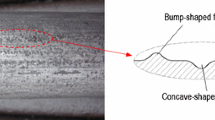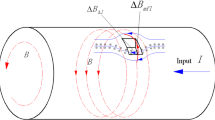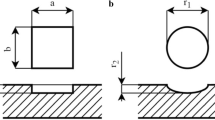Abstract
The application of magnetic sensors in the traditional magnetic flux leakage (MFL) technique has a significant influence on the detection results. The sensor is typically used to directly measure the amplitude of the magnetic leakage flux intensity as the detection signal. In view of noise effects on the detection result and the subsequent misinterpretation of defect signals, a new non-destructive testing method is proposed. The proposed method intends to measure the magnetic flux change rate using two sensors. A mathematical model is first established to present the principle of the change rate measurement. Based on the magnetic dipole theory, it is inferred that the new method is applicable and sensitive to the detection and location of defects. Moreover, this method is advantageous as it inhibits the interference of MFL noises such as the distension noise, background noise, and vibration noise. The model predictions are then verified by a series of simulations. Finally, an experimental platform is set up to practically detect the defect of a steel plate, and the results agree with the demonstrations and simulations.










Similar content being viewed by others
References
Wagner, R., Goncalves, O., Demma, A.: Guided wave testing performance studies: comparison with ultrasonic and magnetic flux leakage pigs. Insight 4, 187–796 (2013). doi:10.1784/insi.2012.55.4.187
Fernandes, B., Titus, M., Nims, D.K., et al.: Field test of magnetic methods for corrosion detection in prestressing strands in adjacent box-beam bridges. J. Bridge Eng. 6, 984–988 (2012). doi:10.1061/(ASCE)BE.1943-5592.0000379
Strapacova, T., Janousek, L., Milan, S.: Evaluation of Advanced Sensor Types under Harmonic Excitation in ECT. Electromagn. Nondestruct. Eval. (XVI) (2014). doi:10.3233/978-1-61499-354-4-9
Chady T., Psuj, G.: Comparative study of multidirectional transducers for evaluation of magnetic materials. Electromagn. Nondestruct. Eval. (XIII) (2010). doi:10.3233/978-1-60750-554-9-223
Yahia, I.S., AlFaifyS, Y.F., et al.: Impedance spectroscopy of n-CdTe/p-CdMnTe/p- GaAs diluted magnetic diode. J. Electron. Mater 8, 2768–2772 (2015). doi:10.1007/s11664-015-3707-7
Kim, J., Lee, J., Jun, J., et al.: Integration of hall and giant magnetoresistive sensor arrays for real-time 2-D visualization of magnetic field vectors. IEEE Trans. Magnet. 11, 3708–3711 (2012). doi:10.1109/TMAG.2012.2200662
Goktepe, M.: Investigation of B-x and B-y components of the magnetic flux leakage in ferromagnetic laminated sample. Adv. Mater. Sci. Eng. (2013). doi:10.1155/2013/708396
Wu, D.H., Zhang, Z.Y., Liu, Z.L., et al.: 3-D FEM simulation and analysis on the best range of lift-off values in MFL testing. J. Test. Eval. (2015). doi:10.1520/JTE20130133
Jungmin, K., Jinyi, L., Jongwoo, J.: Integration of hall and giant magnetoresistive sensor arrays for real-time 2-D visualization of magnetic field vectors. IEEE Trans. Magnet. 11, 3447–3451 (2012). doi:10.1109/TMAG.2012.2200662
Gao, G., Qin, Y., Lian, M., et al.: Detecting typical defects in wire ropes through wavelet analysis. Insight 2, 98–105 (2015). doi:10.1784/insi.2014.57.2.98
Kim, J., Angani, C.S., Le, J., Le, M., et al.: Magnetic leakage testing using linearly integrated hall and GMR sensor arrays to inspect inclusion in cold-rolled strips. IEEE Trans. Magnet. 50(11), 1–4 (2014). doi:10.1109/TMAG.2014.2326856
Kasai, N., Miura, K.: Detection of a Surface flaw using differential signals of MI sensors with residual magnetization method. High Press. Technol. Nondestruct. Eval. Division 241–244 (2012)
Changrong, L.I.A.O., Zheng, L.I.A.O., Liang, H.A.N., et al.: Analytical study on crack magnetic flux leakage for ferromagnetic component and detection system based on geomagnetic field. J. Chongqing Univ. 10, 76–84 (2012). doi:10.11835/j.issn.1000-582X.2012.10.012
Dutta Sushant, M., Ghorbel Fathi, H., Stanley Roderic, K.: Dipole modeling of magnetic flux leakage. IEEE Trans. Magnet. 4, 1959–1965 (2009). doi:10.1109/TMAG.2008.2011895
Kim, H.M., Park, G.S.: Defect estimation of a crack in underground pipelines by CMFL type NDT system. J. Electr. Eng. Technol. 6, 2218–2223 (2014). doi:10.5370/JEET.2014.9.6.2218
Wang, P., Xiong, L., Sun, Y.: features extraction of sensor array based pmfl technology for detection of rail cracks. Measurement 47, 613–626 (2014). doi:10.1016/j.measurement.2013.09.047
Yanhua, S., Yihua, K.: A new MFL principle and method based on near-zero background magnetic field. NDT & E Int. 4, 348–353 (2010). doi:10.1016/j.ndteint.2010.01.005
Gan, Z., Salman, E., Stanacevic, M.: Figures-of-merit to evaluate the significance of switching noise in analog circuits. IEEE Trans. Very Large Scale Integr. (VLSI) Syst. 12, 2945–2956 (2015). doi:10.1109/TVLSI.2014.2386315
Yan, S., Chao, Z., Rui, L.: Theory and application of magnetic flux leakage pipeline detection. Sensors 6, 31036–31055 (2015). doi:10.3390/s151229845
Liu, B., Cao, Y., Zhang, H.: Weakmagnetic flux leakage: a possible method for studying pipeline defects located either inside or outside the structures. NDT & E Int. 74, 81–86 (2015). doi:10.1016/j.ndteint.2015.05.008
Edwards, C., Palmer, S.B.: The magnetic leakage field of surface breaking cracks. J. Phys. D 4, 657–673 (1986). doi:10.1088/0022-3727/19/4/018
Mandache, C., Clapham, L.: A model for magnetic flux leakage signal predictions. J. Phys. D 20, 2427–2431 (2003). doi:10.1088/0022-3727/36/20/001
Acknowledgements
This work was supported by Collaborative Innovation Center of High-End Equipment Manufacturing in Fujian, Science and Technology Major Project of Fujian Province (2015HZ0002-1) and National Natural Science Foundation (51677158), China.
Author information
Authors and Affiliations
Corresponding author
Rights and permissions
About this article
Cite this article
Dehui, W., Lingxin, S., Xiaohong, W. et al. A Novel Non-destructive Testing Method by Measuring the Change Rate of Magnetic Flux Leakage. J Nondestruct Eval 36, 24 (2017). https://doi.org/10.1007/s10921-017-0396-6
Received:
Accepted:
Published:
DOI: https://doi.org/10.1007/s10921-017-0396-6




